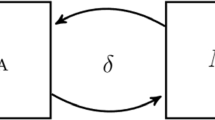Abstract
Many problems in ecology require the estimation of rates of dispersal of individuals or propagules across physical boundaries. Such problems arise in invasion ecology, forest dynamics, and the neutral theory of biodiversity. In a forest plot, for example, one might ask what proportion of the seed rain originates from outside the plot. A recent study presented analytical approximations that relate the rate of immigration across a boundary to plot geometry and to the parameters of a dispersal kernel in one- and two-dimensional environments. In this study, we provide a more rigorous derivation of these expressions and we derive a more general expression that applies in environments of arbitrary dimension. We discuss potential applications of the one-, two-, and three-dimensional results to ecological problems.


Similar content being viewed by others
References
Abramowitz, M. & Stegun, I. A. (Eds.) (1972). Handbook of mathematical functions with formulas, graphs, and mathematical tables. New York: Dover.
Bowman, J., Cappuccino, N., & Fahrig, L. (2002). Patch size and population density: the effect of immigration behavior. Conservation Ecology, 6(1), 9.
Brown, J. H., & Kodric-Brown, A. (1977). Turnover rates in insular biogeography—effect of immigration on extinction. Ecology, 58(2), 445–449.
Chisholm, R. A., & Lichstein, J. W. (2009). Linking dispersal, immigration and scale in the neutral theory of biodiversity. Ecology Letters, 12(12), 1385–1393.
Colautti, R. I., Grigorovich, I. A., & MacIsaac, H. J. (2006). Propagule pressure: a null model for biological invasions. Biological Invasions, 8(5), 1023–1037.
Dolan, J. R., Ritchie, M. E., & Ras, J. (2007). The “neutral” community structure of planktonic herbivores, tintinnid ciliates of the microzooplankton, across the tropical pacific ocean. Biogeosciences, 4(3), 297–310.
Hubbell, S. P. (2001). The unified neutral theory of biodiversity and biogeography. Princeton: Princeton University Press.
Kot, M., Lewis, M. A., & van den Driessche, P. (1996). Dispersal data and the spread of invading organisms. Ecology, 77(7), 2027–2042.
Levey, D. J., Tewksbury, J. J., & Bolker, B. M. (2008). Modelling long-distance seed dispersal in heterogeneous landscapes. Journal of Ecology, 96(4), 599–608.
Lewis, M. A., & Kareiva, P. (1993). Allee dynamics and the spread of invading organisms. Theoretical Population Biology, 43(2), 141–158.
Lichstein, J. W., & Pacala, S. W. (2011). Local diversity in heterogeneous landscapes: quantitative assessment with a height-structured forest metacommunity model. Theoretical Ecology, 4(2), 269–281.
Liu, J., & Ashton, P. S. (1998). Formosaic: an individual-based spatially explicit model for simulating forest dynamics in landscape mosaics. Ecological Modelling, 106(2–3), 177–200.
Loreau, M., & Mouquet, N. (1999). Immigration and the maintenance of local species diversity. American Naturalist, 154(4), 427–440.
Rogers, C. A. (1999). Hausdorff measures. Cambridge: Cambridge University Press.
Scheffer, M., Rinaldi, S., Huisman, J., & Weissing, F. J. (2003). Why plankton communities have no equilibrium: solutions to the paradox. Hydrobiologia, 491(1–3), 9–18.
Woodcock, S., van der Gast, C. J., Bell, T., Lunn, M., Curtis, T. P., Head, I. M., & Sloan, W. T. (2007). Neutral assembly of bacterial communities. FEMS Microbiology Ecology, 62(2), 171–180.
Acknowledgements
We thank William Allard, Frank Morgan, James O’Dwyer, Rachel Ward, and Hyam Rubenstein for helpful discussion. We thank two anonymous reviewers for comments that improved the manuscript. This research was partly funded by the grant, Microstates to Macrodynamics: A New Mathematics of Biology, Defense Advanced Research Projects Agency (HR0011-05-1-0057).
Author information
Authors and Affiliations
Corresponding author
Appendices
Appendix A
Here, we present a derivation of an exact expression for \(\hat{m}(r)\) for the special case where the region G is a disc in ℝ2, so that the boundary X is a circle. Recall that \(\hat{m}(r)\) is defined by Eq. (2) and represents the immigration rate for a fixed dispersal distance r.
Let R be the radius of the circle X and assume that r<R. First, consider a point P in G at a distance x≤r from the circle (we can ignore other points in G because no dispersal events can reach them). Consider an isosceles triangle defined by three points: P, and the two points on X that are at a distance r from P. Let 2θ x be the angle at P. From the law of cosines, we have
An expression for \(\hat{m}(r)\) can be obtained by integrating over all possible points P in x:

This integral can be evaluated using the following substitution:
which gives

Integrating this by parts and simplifying leads to
We can also write this as a Taylor series:
It is clear that this last result is consistent with Eq. (6) in the main text. The key point to note here is that the curvature of the circle introduces higher-order polynomial terms in r/R, but that these terms vanish asymptotically as r/Φ=r/(2πR)→0.
Appendix B
To evaluate the inner integral in Eq. (5) we require the general formula for the hypersurface area of an n-dimensional hypersphere of radius r:
and the general formula for the hypersurface area of a hyperspherical cap of height h on this hypersphere:

where 2 F 1(a,b,c;z) is the hypergeometric function (Abramowitz and Stegun 1972). Evaluating (5) now just requires some technical integration:

The integral of the hypergeometric function can be evaluated using the identity:
with the substitution z=(u/r)2 giving
Substituting this back into the integral of A(C n (r,r−u)) and simplifying gives
Then returning to Eq. (5), we have
Rights and permissions
About this article
Cite this article
Chisholm, R.A., Levin, S.A. Linking Dispersal and Immigration in Multidimensional Environments. Bull Math Biol 74, 1754–1763 (2012). https://doi.org/10.1007/s11538-012-9734-0
Received:
Accepted:
Published:
Issue Date:
DOI: https://doi.org/10.1007/s11538-012-9734-0




